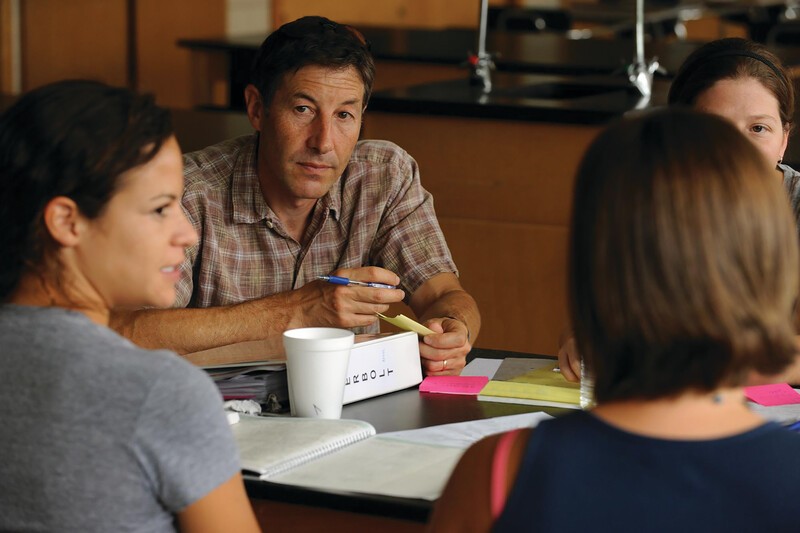Complimentary Co-Teaching
I co-taught with a seasoned urban educator in Chicago during my first years of teaching. We quickly became a dynamic duo in our 11th grade classes. Our skills complemented each other, as did our age and gender differences. I came to the classroom with new ideas, which he embraced and was able to iron out on the basis of his decades of experience. He could tell a great story, while my strengths were technology and bringing art into our history lessons. We could be mom and dad to our high school students, which made us better able to meet our students' needs; there was someone for each student to relate to or confide in.
These were my best years as a teacher, as I was collaborating, learning, growing, and teaching all at once! What made it work was our partnership in all things (classroom management, instruction, differentiation, and assessment); daily common planning time; and our differing and equally valuable skill sets.
—Alexis Boyden, former assistant principal and special education teacher, Grand Rapids, Michigan
More Teachers, More Waste
I've observed many classrooms where teachers were labeled as "co-teachers." Unfortunately, I've found that most don't know how to co-teach. Rather than collaborating, the teams would divide the subjects between themselves, with each teaching for half the time. One teacher lectured, and the other graded papers, listened, or walked around the room. Questioning these teams revealed only occasional shared planning.
These classrooms were often called "million-dollar classrooms" because of the heavy staffing; unfortunately, there were no million-dollar results.
—Kay W. Kelly, semi-retired administrator, Indianapolis, Indiana
Learning from Two Perspectives
As a teacher educator of undergraduate students, I've co-taught a class on educational technology with a technology expert. Together, we were able to share the best of our expertise, providing our students with real ways to integrate technology in the classroom and exploring the latest technologies. It was a wonderful learning experience for both of us as teachers; we shared the administrative workload, and our students learned a lot more from two different perspectives!
—Maria Dolores Lasso, academic director, Universidad San Francisco de Quito, Quito, Ecuador
Learning from a Master Teacher
During my first year as a middle school teacher, I had the honor to co-teach with a master teacher. My contribution was maximized, and our students were successful. Our intentional planning and targeted outcomes resulted in increased mastery and more inquisitive thinking from our students. In addition, the opportunity to support Response to Intervention (RTI) students with differentiated instruction accelerated their learning and moved students from Tier 2 to Tier 1.
—Lashay Johnson, elementary supervisor, Edison Public School District, Edison, New Jersey
Helping All Kids Succeed
I have been a special education teacher in a co-teaching classroom for the past three years. To me, what makes co-teaching a wonderful experience for students is a common belief that all kids can learn—and succeed—but that some kids need accommodations and modifications to help. The regular education teacher must support this concept.
Also, the strength of any co-teaching environment is joint planning time; I am fortunate to have a principal who believes in this!
Finally, the dynamic between the regular and special education teacher must be seamless within the classroom. There are two teachers helping and teaching all students; there should never be a divide between which teacher helps certain students.
—Jessica Weigel, learning support teacher, West Hills Primary, Armstrong School District, Kittanning, Pennsylvania
Co-Teaching with Tech
I recently co-taught with a 5th grade social studies classroom teacher. We assigned each student an historical figure from the American Revolution, and I taught them digital research strategies and tools. Each student created a humorous digital comic strip using this research. It was amazing how the students made their characters interact. All students were engaged, and history came alive!
—Lou Anne Miller, instructional technology coach, Saratoga Elementary, Lincoln Public Schools, Lincoln, Nebraska
Observing in Tandem
When I taught 2nd grade many years ago, my in-class support teacher and I monitored our students as they worked independently on their math assignments. We were both aware of our students' strengths, academic needs, and approaches to problem solving. One student in particular was able to complete assignments most successfully if given tactile resources to manipulate. He often counted by tapping his chin. We realized that, with these resources and his chin, he was able to solve complex, multistep math problems independently.
One day, as I was working with a small group at a separate table, my co-teacher asked me to observe this student; instead of tapping his chin, he was tapping his forehead. She asked, "What do you think he's doing?" I responded, "higher-order thinking!" As we giggled, we realized we were both in tune with our students, their habits, levels, and needs.
We had such a high level of respect for each other's professional knowledge that we were able to bounce ideas off each other and consistently work together to optimize the individual learning in the classroom, while laughing and enjoying the wonderful profession of teaching.
—Georgette Boulegeris, principal, Somerville Public Schools, Somerville, New Jersey
An Inclusive Team
I teach biology with a special education co-teacher in an inclusion classroom. We are hugely successful because we both bring a sense of wonder and awe to the classroom. The activities we create together inspire our students to reach higher. We use the same language with our students—let's "think like scientists," or "what are you trying to learn today?"—so our students see us as a team in many ways. Another factor in our success is that we take turns teaching the content or managing labs or other activities. This allows each of us to observe our students from a different perspective.
—Cindy Kube, science teacher, Virginia Beach City Public Schools, Virginia Beach, Virginia



